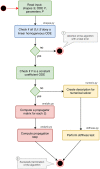Automatically Selecting a Suitable Integration Scheme for Systems of Differential Equations in Neuron Models
- PMID: 30349471
- PMCID: PMC6186990
- DOI: 10.3389/fninf.2018.00050
Automatically Selecting a Suitable Integration Scheme for Systems of Differential Equations in Neuron Models
Abstract
On the level of the spiking activity, the integrate-and-fire neuron is one of the most commonly used descriptions of neural activity. A multitude of variants has been proposed to cope with the huge diversity of behaviors observed in biological nerve cells. The main appeal of this class of model is that it can be defined in terms of a hybrid model, where a set of mathematical equations describes the sub-threshold dynamics of the membrane potential and the generation of action potentials is often only added algorithmically without the shape of spikes being part of the equations. In contrast to more detailed biophysical models, this simple description of neuron models allows the routine simulation of large biological neuronal networks on standard hardware widely available in most laboratories these days. The time evolution of the relevant state variables is usually defined by a small set of ordinary differential equations (ODEs). A small number of evolution schemes for the corresponding systems of ODEs are commonly used for many neuron models, and form the basis of the neuron model implementations built into commonly used simulators like Brian, NEST and NEURON. However, an often neglected problem is that the implemented evolution schemes are only rarely selected through a structured process based on numerical criteria. This practice cannot guarantee accurate and stable solutions for the equations and the actual quality of the solution depends largely on the parametrization of the model. In this article, we give an overview of typical equations and state descriptions for the dynamics of the relevant variables in integrate-and-fire models. We then describe a formal mathematical process to automate the design or selection of a suitable evolution scheme for this large class of models. Finally, we present the reference implementation of our symbolic analysis toolbox for ODEs that can guide modelers during the implementation of custom neuron models.
Keywords: ODE; integrate-and-fire neuron; integration schemes; model dynamics; numerics; symbolic analysis.
Figures







References
-
- Benker H. (2016). MATHEMATICA kompakt: Mathematische Problemlösungen fr Ingenieure, Mathematiker und Naturwissenschaftler. Wiesbaden: Springer.
-
- Carnevale N. T., Hines M. L. (2006). The NEURON Book. New York, NY: Cambridge University Press.
-
- Dahmen W., Reusken A. (2005). Numerik fr Naturwissenschaftler. Berlin: Springer.
LinkOut - more resources
Full Text Sources

